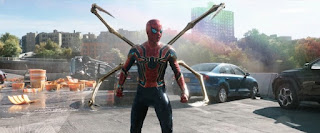Spider-Man might be a superhero who deserves to be on the Avengers team. But are his abilities really within the limits of what spiders can do? How accurate is Spider-Man's powers compared to his real-life counterparts?
The hype of the recently released Spider-Man No Way Home has piqued arachnologist or spider expert Rod Crawford who is also a curator at the Burke Museum in Seattle, Washington, United States.
Quoted from Science Focus, Crawford exposes spider-fact and spider-fiction to explain the fact and fiction of spiders that are actually seen from the perspective of science.
Strength
Spider-Man's super strength is described as being able to lift loads many times his own weight. Therefore, if humans had spider-like abilities, they could also lift loads many times their own weight.
But Crawford was skeptical of the idea. He cited the law of the squares of the cubes, a Mathematical principle which states that when an object increases in size proportionally, its new volume is proportional to the cube of the multiplier and its new surface area is proportional to the square of the multiplier.
Basically, this formula explains that as an object grows larger, so does the tension and demand on that object.
"Strength is not directly measured by size. The smaller you are, the easier it is to lift large objects, because large objects themselves are less heavy. The larger you are, the harder it is to lift large objects because the weight of large objects increases much faster than your strength. myself," said Crawford.
"Spiders have almost the same strength as insects of the same size range, and spiders in webs are able to lift prey that weighs several times heavier than spiders. But in an absolute sense the load is still very light."
Agility
Spider-Man's reflexes are very fast, suited to certain types of spiders. According to Crawford, some spiders are very fast. There is a land spider found only in North America, which in body length per second, can run relatively twice as fast as a cheetah.
"However, if it is scaled up to human size, it can't work at all, because of the law of the square cube," said Crawford.
What about moves like jumping? Crawford says some spiders are good at jumping, and others. In addition, spider jumps are performed in a very different way from the jumps of creatures like us which have the inner bones in our legs surrounded by muscles.
"Spiders' legs don't have any extensor muscles at all. So when they stick their legs out to jump, it's not done by muscles, it's the hydraulic pressure of the blood," explains Crawford.
Crawling on the wall
There is no single explanation for Spider-Man's ability to stick and climb walls. The explanation for Spider-Man in the original comic book, for example, is that this superhero can bind himself to a wall surface through electrostatic forces.
While in the film, Peter Parker is seen to have fine, sharp hair that grows on the tips of his fingers. These sharp hairs allow it to grip surfaces. In reality, the method seems somewhat similar to the spider fact.
"Every spider can climb rough brick walls because they have claws. But jumping spiders and some other groups have special microscopic hairs on the tips of their feet that are capable of sticking to smooth surfaces," explains Crawford.
Spider hairs contain hundreds of thousands of even smaller hairs called setules, which can utilize van der Waals forces, the attraction of intermolecular forces between molecules, to create temporary molecular bonds with surfaces. Scientists have concluded that these bonds are so strong that the spider can carry 173 times its body weight when attached to a surface.
Spider webs
Spider-Man's cobwebs are surprisingly strong. For example, in one scene in Spider-Man Homecoming, the spider web is described as tough enough to prevent the ferry from splitting in two. Although in the film it looks lame, this characteristic is similar to the fact that spider webs are actually real.
"Ordinary spider thread is only a few microns thick. However, it is much stronger than something like ordinary steel wire. Cobwebs are probably the strongest natural fibers known," says Crawford.
This is why scientists are trying to artificially reproduce spider silk for use in bicycle helmets and single-use plastics.
Seeing Spider-Man use his web to swing through skyscrapers doesn't seem far-fetched. Crawford said spiders do swing from high to low using the threads they produce.
Spider sense
One of Spider-Man's most famous powers is his spider senses which gives him the ability to sense danger before it occurs. An omen is coming, represented by a tingling feeling on the back of his neck.
"Danger is subjective," said Crawford, who is skeptical of the idea that spiders can sense warnings of danger before it occurs. "That sounds more like a hunch. And I don't believe there are studies that show a hunch in spiders," he said.
A spider's real sense, Crawford explains, is to adapt to their local environment, but it has limits. Spiders have hair that is very sensitive to air vibrations. Including the very specific frequencies of what we call sound.
"They also have what we call a sense of chemotaxis, which might be described as smell by touch. Only some spiders can detect odors in the air," he explained.
"And as for their eyesight, that ability varies by type of spider. Jumping spiders have some of the best eyesight in the animal kingdom, almost as good as humans. However, the eyes of house spiders cannot form recognizable images at all, " he closed.


